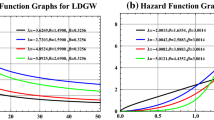Abstract
Upon the motivation of unstable climatic conditions of the world like excess of rains, drought and huge floods, we introduce a versatile hydrologic probability model with two scale parameters. The proposed model contains Lindley and exponentiated exponential (Lindley in J R Stat Soc Ser B 20:102–107, 1958; Gupta and Kundu in Biom J 43(1):117–130, 2001) distributions as special cases. Various properties of the distribution are obtained, such as shapes of the density and hazard functions, moments, mean deviation, information-generating function, conditional moments, Shannon entropy, L-moments, order statistics, information matrix and characterization via hazard function. Parameters are estimated via maximum likelihood estimation method. A simulation scheme is provided for generating the random data from the proposed distribution. Four data sets are used for comparing the proposed model with a set of well-known hydrologic models, such as generalized Pareto, log normal (3), log Pearson type III, Kappa(3), Gumbel, generalized logistic and generalized Lindley distributions, using some goodness-of-fit tests. These comparisons render the proposed model suitable and representative for hydrologic data sets with least loss of information attitude and a realistic return period, which render it as an appropriate alternate of the existing hydrologic models. Supplementary materials for this paper are available online.






Similar content being viewed by others
References
Abida, H. Ellouze, M. (2008), “Probability distribution of flood flows in Tunisia”, Hydrology and Earth System Sciences, 12, 703–714.
Balakrishnan, N. Leung, MY.(1988), “Means, variances and covariances of order statistics, BLUEs for the Type-I generalized logistic distribution, and some applications”, Communications in Statistics Simulation and Computation, 17(1), 51–84.
Bobee, B.(1975), “The Log Pearson Type 3 Distribution and Its Application in Hydrology”, Water Resource Research, 11(5), 681–689.
Bolgov, M. Korobkina, E. (2013), “Applying the Log Pearson Type 3 Distribution for modeling Annual Inflow to the closed Lake”, ICWRER 2013 Proceeding, 286–297. https://doi.org/10.5675/ICWRER-2013.
Choulakian, V. Stephens, M.A.(2001), “Goodness of fit for the generalized Pareto distribution”, Technometrics, 43, 478–484.
Dargahi-Noubary, G.R.(1989), “On tail estimation: An improved method”, Mathematical Geology, 21 (8), 829–842.
DeCarlo, L.T. (1997), “On the Meaning and Use of Kurtosis”, Psychological Methods 2(3), 297–307.
Dyrrdal, A.V. (2012), “Estimation of extreme precipitation in Norway and a summary of the state-ofthe-art”, Report No. 08/2012, Climate, Norwegian Meteorological Institute.
Ewemoje, T.A. and Ewemooje, O.S.(2011), “Best Distribution and Plotting Positions of Daily Maximum Flood Estimation at Ona River in Ogun-Oshun River Basin, Nigeria”, Agricultural Engineering International:CIGR Journal, 13(03), 1–13.
Gupta, R.D. and Kundu, D. (2001), “Exponentiated Exponential Family: An Alternative to Gamma and Weibull Distributions”, Biometrical Journal, 43(1), 117–130.
Hosking, J.R.M.(1990), “L-moments: analysis and estimation of distribution using linear combinations of order statistics”, Journal of the Royal Statistical Society B, 52, 105–124.
Hosking, J.R.M.and Wallis, J.R. (1987), “Parameter and quantile estimation for the Generalized Pareto Distribution”, Technometrics, 29(3), 339–349.
IPCC (2002). “Workshop on changes in extreme weather and climate events”, Workshop report, Beijing, China, 11–13 June, 2002, pp. 107.
Johnson, N.L., Kotz, S.and Balakrishnan, N. (1994), Continuous Univariate Distributions, Volume 1, \(2^{nd}\) Edition. New York: John Wiley and Sons.
Junior, P.W.M. and Johnson, E.S. (1973), “Three Parameter Kappa Distribution Maximum Likelihood Estimates and Likelihood Ratio Tests”, Monthly Weather Review, 101(09), 701–711.
Krige, D. (1960), “On the Departure of Ore value Distributions from the Log-Normal Model in South African gold mines”, Journal of South Afr. Inst. Min. Metal., 40(1), 231–244.
Kuczera, G. and Frank, S. (2015), Australian Rainfall Runo Book 3, Chapter 2: At-Site Flood Frequency Analysis-Draft, Engineers Australia, 10 March 2015, downloaded 05 October 2015.
Leadbetter, M.R., Lindgren, G. and Rootzen, H. (1987), Extremes and Related Properties of Random Sequences and Processes, Springer Verlag, NewYork.
Lindley, D.V.(1958), “Fiducial distributions and Bayes theorem”, Journal of the Royal Statistical Society, Ser. B, 20, 102–107.
Millington, N., Das, S. and Simonovic, S.P. (2011), “The Comparison of GEV, Log-Pearson Type 3 and Gumbel Distributions in the Upper Thames River Watershed under Global Climate Models”, Water Resources Research Report. Book 40. http://ir.lib.uwo.ca/wrrr/40.
Mujere, N. (2011), “Flood Frequency Analysis Using the Gumbel Distribution”, International Journal on Computer Science and Engineering, 3(7), 2774–2778.
Murshed, M.S.(2011), Statistical analysis to extreme values with applications to hydrologic events.Unpublished PhD(Statistics) Thesis, Department of Statistics Graduate School of Chonnam National University, Korea.
Pegram, G.G.S. (2009), Hydraulic Structures, Equipment and Water data Acquisition Systems-Vol.I, Chapter:Probabilistic Methods and Stochastic Hydrology. Available at : http://www.eolss.net/sample-chapters/c07/e2-15-02-05.pdf.
Rohatgi, V.K. and Saleh A.K.Md.E.(2002), An Introduction to Probability and Statistics 2002; John-Wiley
Sandoval, C.A.E. (2009), “Mixed Distributions in Low-Flow Frequency Analysis”. RIIT , X(3), 247–253.
Simpson, J.(1972), “Use of Gamma Distribution in Single Cloud Rainfall Analysis”, Monthly Weather Review, 100(4), 309–312.
Tahir, M.A. and Cordeiro, G.M.(2016), “Compounding of distributions: a survey and new generalized classes”, Journal of Statistical Distributions and Applications, 3(13), 1–35.
Xu, Y.P., Booij, M.J. and Tong, Y.B. (2010), “Uncertainty analysis in statistical modeling of extreme hydrological events”. Stoch Environ Res Risk Assess, 24, 567–578.
Zakerzadeha, H. and Dolati A. (2009), “Generalized Lindley Distribution”, Journal of Mathematical Extension, 3(2), 13–25.
Acknowledgements
Authors would like to thank the two anonymous referees for their constructive comments and suggestions that greatly improved this manuscript. Authors also are grateful to Muhammad Nauman Khan for his help on editing the Latex template.
Author information
Authors and Affiliations
Corresponding author
Electronic supplementary material
Below is the link to the electronic supplementary material.
Appendix
Appendix
In this appendix, we state the partial derivatives of the log-likelihood function (5) with respect to the unknown parameters \(\theta \), \(\alpha \) and \(\beta \) as
The second derivatives that exist in the elements of the \(3\times 3\) information matrix are given as
Rights and permissions
About this article
Cite this article
Hussain, T., Bakouch, H.S. & Iqbal, Z. A New Probability Model for Hydrologic Events: Properties and Applications. JABES 23, 63–82 (2018). https://doi.org/10.1007/s13253-017-0313-6
Received:
Accepted:
Published:
Issue Date:
DOI: https://doi.org/10.1007/s13253-017-0313-6




